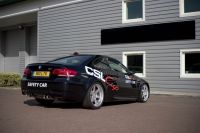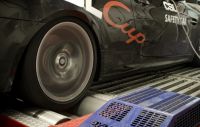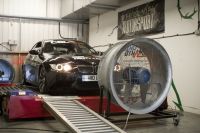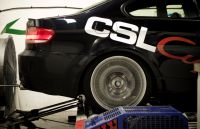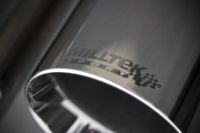By John Thorne – Tue, 12 May 2009 14:30
I do have huge sympathy for car designers, they must develop and deliver product to an ever widening customer type and attempt to supply the impossible to very demanding owners. However just because I understand the difficulties they face does not mean I’m not unhappy with the obvious shortcomings of the product. The seat belt ‘helpers’ for example, these are little arms that happily hand you the seat belt when you get in, nice idea you think but the fact they either take too long to come out or disappear too quickly to be of any use soon marks them as a pain in the arse pretty quickly. The start button also generates annoyance, I can understand the need to put your foot on the clutch but do you really need to keep pressing it long after the engine has clearly fired, remove your foot too quickly and the engine dies., my neighbours are starting to think I cant start this thing. The ipod interface works well enough but is slow to load, the radio display is dated, the satnav is slower than a slow thing and offers an increasingly perplexing choice of routes that defy belief (Oxford to Nottingham via the M25 anyone?) and the least said about the Bluetooth car kit the better, I’m sure if and when I do get caught for using my phone in the car I have a justifiable excuse for the police when I say “it’s the BMW car kit officer, it really is that shit”
These little things are annoying enough but part and parcel of a car really, after all nothing is perfect but the car is showing its Achilles heel pretty quickly – handling. Now the plan for this next article was to address this, we’ve developed a few things from lowering springs to full suspension for the car but the fact is we’re not quite there yet as we’re struggling a little bit to get what we (and what we think other owners) really want. The main issue is the steering feel and the overall feeling of remoteness from the helm that you get really is affecting the enjoyment of the car. Going quickly is easy enough but the issue is that whilst its quite possible to pilot the car at very high speeds (on track of course) the fact is that the level of handling communication never really rises as it does with an E46 – not good. As a result we’re going to deal with some nice easy upgrades this month, in dotcome parlance some ‘low hanging fruit’ – power and noise.
Before everyone gets all excited that we’re dealing with power so early calm down, the power upgrades for this car are a long term development so we can’t just deal with it in one hit, several stages are planned (and some already developed) from ECU remapping to major engine work but a lot of people don’t like to mess with a new cars electronics (warranty blah blah) so we’ve concentrated in these early stages on some nice bolt on gains you can sometimes get from items like exhausts.
Our long term exhaust development partner is Milltek Sport, based in Derby (the patriot in me always thinks its nice to deal with a UK company) their reputation is more based in the Audi/VW marques where they are the leading supplier to models such as the RS4/5/6 and the burgeoning range of Golfs and TT’s. However over the last 6 years or so we have been working quite closely together to develop exhausts for the BMW range, notable success’s have been the E46 M3 and CSL, the E39 M5 and the new 335i.
Developing an exhaust for a new model is relatively straight forward but hugely time consuming, first off we need to test the standard cars power output. We can’t just test one car of course but several to get an idea of what kind of standard power these cars do achieve and sadly it’s relatively usual to find that real life power outputs to do not quite reach and this applies to the E92 M3. BMW state the power output as 420bhp (as measured at the flywheel) and sadly we’ve not yet seen a standard car to achieve this, most achieve in the region of 405-410bhp. Before you jump on BMW the reason for this difference is not simply one of fraud on BMW’s behalf but is more a symptom of how cars are measured for power in the EU, here the manufacturers use power measured at the flywheel rather than measured at the wheels and as flywheel power can only really be measured on an engine dyno and its pretty impractical to remove a cars engine each time you want to measure a cars output. At Thorney Motorsport we have our own Dyno Dynamics chassis dyno, one of the best available in the market, the Dyno Dynamics dynos are World renowned for being 100% accurate and impossible to ‘fudge’ figures – we like that. We also have access to a full engine dyno which we do use for fuel testing amongst other things but for the purposes of vehicle development the chassis dyno is best. Chassis dyno’s measure power as delivered at the wheels which is a far better way of measuring a car as this is what actually drives the car along the road rather than a pure engine figure. Manufacturers in the EU use flywheel figures and there are all kinds of tricks they like to use to maximise this number; chilling the fuel, disconnecting the air conditioning pump etc etc, all these little things can increase the engine power when compared to how you drive it – in the car itself. For this reason we develop and measure all cars on both power at the wheels and at the flywheel – we like to be thorough. I’ll go through other aspects of power measurement of these cars in the next features.
Exhausts are both relatively simple and also enormously complicated to develop, end of the day their job is pretty straight forward – take gases from the engine and expel them as efficiently as possible – the quicker the gases are expelled the more power the engine can develop, however the devil is in the detail and there are three main areas to consider – manifold, catalytic converter and the cat back, for the purposes of this feature we’re going to concentrate on the easy bit – the cat back.
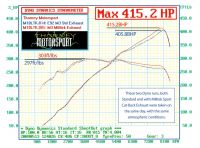 The cat back part of the exhaust is exactly as it sounds, it’s the exhaust from the catalytic converter backwards and includes the rear silencer – the bit you actually see and contrary to popular belief is rarely responsible for any real power gains but more for noise. However sometimes manufacturers offer us in the tuning industry an easy win and one of these times is the E92 M3. If you look at the standard exhaust (from the cat back) you can clearly see how BMW have had to crimp the tubes to get clearance around the drive shaft, the moment we saw that we knew we had a good chance of getting some easy power just from a catback – cool. Its fairly typical for manufacturers to cut costs on exhaust design, after all the majority of owners couldn’t care less about it as all they see is the last 2 inches of tail pipe so the incentive to keep the cost down is overwhelming but this does mean that with some careful thought we can get useful performance gains. Usually these gains are limited to weight loss and of course a more sporting note but with the E92 M3 we’ve managed to get some good real life power gains. To do this we’ve re-designed the rear silencer to maximise airflow through the box, widened the bore of the pipework and simplified the flow of air through the system – all simple stuff but the gains we have achieved are actually pretty impressive – a clear 10bhp increase, that’s very impressive from a catback system.
The cat back part of the exhaust is exactly as it sounds, it’s the exhaust from the catalytic converter backwards and includes the rear silencer – the bit you actually see and contrary to popular belief is rarely responsible for any real power gains but more for noise. However sometimes manufacturers offer us in the tuning industry an easy win and one of these times is the E92 M3. If you look at the standard exhaust (from the cat back) you can clearly see how BMW have had to crimp the tubes to get clearance around the drive shaft, the moment we saw that we knew we had a good chance of getting some easy power just from a catback – cool. Its fairly typical for manufacturers to cut costs on exhaust design, after all the majority of owners couldn’t care less about it as all they see is the last 2 inches of tail pipe so the incentive to keep the cost down is overwhelming but this does mean that with some careful thought we can get useful performance gains. Usually these gains are limited to weight loss and of course a more sporting note but with the E92 M3 we’ve managed to get some good real life power gains. To do this we’ve re-designed the rear silencer to maximise airflow through the box, widened the bore of the pipework and simplified the flow of air through the system – all simple stuff but the gains we have achieved are actually pretty impressive – a clear 10bhp increase, that’s very impressive from a catback system.
This increase in power is immediately noticeable in the car, the throttle feels sharper and acceleration just that little bit more urgent, for a simple bolt on part the gains couldn’t be better, we’re delighted. The weight loss from the exhaust is also substantial – 6.75kg, considering the E92 is so heavy as standard any weight loss is worth having. The fact its made from stainless steel so wont rot and has a lifetime guaranty is the icing on the cake.
But….what about noise?
The E92 M3 has a lovely V8, the engine alone makes a lovely noise as you’d expect from its configuration but exhaust noise is pretty muted – too muted so we developed the system to generate a nice sporty note. At low rpm it has a nice throaty rumble, nothing too intrusive and certainly lets you know that there is a V8 under the bonnet but as revs rise the exhaust generates a lovely V8 wail that suits the high revving engine, the higher the rpm the louder and more aggressive the sound – lovely. Due to the track work this car will have to undertake we have deliberately made sure that the overall exhaust volume will still pass UK noise regulations this also means that those wanting to track their own cars there is no fear of being black flagged for being too noisy, we will continue this as we develop the rest of the exhaust over the coming weeks.
Next month we’ll either have sorted the handling or more on power, haven’t decided yet – you’ll just have to wait and see!
John
Thorney Motorsport on Facebook




